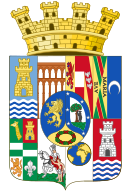Coat of arms of the Community of Madrid
| Coat of arms of the Community of Madrid | |
|---|---|
 | |
| Versions | |
 Emblem (Simplified version) | |
| Adopted | 1983 |
| Crest | Spanish Royal Crown |
| Shield | two castles with turrets and keep, gate and windows azure, masonry sable, overhead seven silver (or white) stars placed four and three |
| Earlier version(s) | see below |
| Use | the complex version is only for works in stone, other construction materials or confectionery |
The coat of arms of the Community of Madrid was adopted in 1983. The field is crimson red with two yellow or golden castles with seven five-pointed white or silver stars on top, arranged four and three. The crest is the Spanish Royal Crown.[1][2]
The red field symbolizes historic Castile, of which Madrid had long been part, and the two castles represent the two Castilian communities and Madrid as their union. The seven stars come from the coat of arms of the capital representing the constellation Ursa Major, which is visible from the city. The five points of the stars refer to the five provinces which about the Community.[3] The royal crown symbolizes Madrid as the royal seat.[4]
Coats of arms of the Province of Madrid
| History of the coat of arms of Madrid Province | |||
| Coat of arms | Dates | Details | |
|---|---|---|---|

|
1872–1873 1874 – c.1920 |
The first version of Madrid Province quarterings and a central inescutcheon were standing for:
| |

|
1873–1874 | During the First Republic, the heraldic open royal crown was replaced by a mural crown.[6] | |

|
c.1920–1931 | Later, reigning King Alfonso XIII, in the third quarter were added the 'ancient' arms of San Lorenzo de El Escorial (Habsbourg, Austria and Lorraine). In the inescutcheon were also introduced the griffin and the civic crown that had been included in the arms of Madrid City in 1859. The 'ancient' open royal crown was replaced by the Spanish Royal Crown.
An example of this achievement can still seen today on the front facade of Las Ventas Bullring.[7][8] | |

|
1931–1939 | During the Second Republic, the Spanish Royal Crown was replaced by a mural crown and the coronets of the heraldic lions of San Lorenzo de El Escorial and Chinchón were also removed.[9] | |

|
1939–1968 | In the Francoist period, the coronets of the heraldic lions were restored, a female bust was introduced over the aqueduct of Navalcarnero and the mural crown was replaced by the heraldic open royal crown as was displayed with the monarchy from 1872 to c.1920.[10] | |

|
1968–1977 | Madrid's provincial division was later rearranged into only five judicial districts, and a new coat of arms was considered, with five quarterings and a central inescutcheon standing for:
| |

|
1977–1983 | In 1977, after King Juan Carlos's accession to the throne, the heraldic open crown used by Franco's regime was replaced by the Spanish Royal Crown and the traditional Iberian escutcheon shape was introduced.[12] | |
See also
References
- ^ Law 2/1983, of 23 December, of the flag, the coat of arms and the anthem of the Community of Madrid
- ^ Decree 2/1984, of 19 January, developing Law 2/1983
- ^ They are Toledo, Guadalajara, Cuenca, Segovia and Avila
- ^ Rules for the Coat of Arms, from the Community Website
- ^ 1872 Coat of arms image. Retrieved 2015-06-23.
- ^ Republican coat of arms image at an insignia Archived 2015-06-23 at the Wayback Machine. Retrieved 2015-06-23.
- ^ Coat of arms Image at Las Ventas Bullring. Retrieved 2015-06-23.
- ^ Coat of arms Image (Detail) Las Ventas Bullring. Retrieved 2015-06-23.
- ^ Image of the Republican coat of arms. Retrieved 2015-06-23.
- ^ "Cisneros: Crónica Provincial" (in Spanish). Diputación Provincial de Madrid. May 1951. p. 8. Retrieved 2015-06-23.
- ^ 1967 Coat of arms image, Sitographics.com.
- ^ a b "Former flag and arms of the Madrid Province". Flags of the World. Retrieved 2015-06-23.
